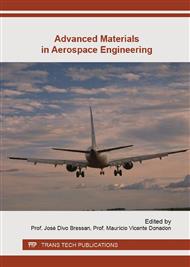[1]
C. Ageorges, L. Ye, Simulation of Impulsive Resistance Welding for Thermoplastic Matriz Composites, Composite Materials. 8 (1999) 133-147.
Google Scholar
[2]
P.J. Bates, S. Tan, G. Zak, M. McLEOD, Shear strength and meltdown behavior of reinforced polypropylene assemblies, Composites: Part A. 40 (2009) 28–35.
DOI: 10.1016/j.compositesa.2008.09.019
Google Scholar
[3]
N.L. Batista. Influência do condicionamento ambiental no desempenho mecânico e térmico de compósitos avançados PEI/FC. Instituto Tecnológico de Aeronáutica (ITA), São José dos Campos, (2012).
DOI: 10.14393/19834071.2014.26671
Google Scholar
[4]
S.T. Button, Metodologia para Planejamento Experimental e Análise de Resultados, Universidade Estadual de Campinas, Faculdade de Engenharia Mecânica, Campinas, (2005).
DOI: 10.20396/revpibic2720192459
Google Scholar
[5]
A.P. Costa, Efeito do condicionamento ambiental em compósitos soldados de PPS/Fibras contínuas. Universidade Estadual Paulista, Faculdade de Engenharia de Guaratinguetá, Guaratinguetá, (2011).
Google Scholar
[6]
M. Dubé, P. Hubert, A. Yousefpour, J. Denault, Fatigue failure characterisation of resistance-welded thermoplastic composites. International Journal of Fatigue. 31 (2009) 719–725.
DOI: 10.1016/j.ijfatigue.2008.03.012
Google Scholar
[7]
J.F.C. Khaw, B. S. Lim, L.E.N. Lim, Optimal design of neural networks using the Taguchi method. Neurocomputing. 3 (1995) 225–245.
DOI: 10.1016/0925-2312(94)00013-i
Google Scholar
[8]
P.V. Marques, P.J. Modenesi, A. Q Bracarense, Soldagem - Fundamentos e Tecnologia, third. ed., UFMG, Belo Horizonte, (2007).
Google Scholar
[9]
D. C Montgomery, Estatística Aplicada e Probabilidade para Engenheiros, second ed., Rio de Janeiro, (2003).
Google Scholar
[10]
B.B. Neto, I.S. Scarminio, R.E. Bruns, Comos Fazer Experimentos - Pesquisa e Desenvolvimento na Ciência e na Indústria, second ed., Editora da Unicamp, Barão Geraldo, (2001).
Google Scholar
[11]
G.F. Nino, T.J. Ahmed, H.E.N. Bersee, A. Beukers, Thermal NDI of resistance welded composite structures, Composites: Part B. 40 (2008) 237-248.
DOI: 10.1016/j.compositesb.2008.10.003
Google Scholar
[12]
M.C. Rezende, M.L. Costa, E.C. Botelho, Compósitos Estruturais - Tecnologia e Prática, first ed., ArtLiber, São Paulo, (2011).
Google Scholar
[13]
F. Silva, J.S. Barbosa, G. Garcia. R. Faez, A.P.F. Albers, Avaliação dos Parâmetros de Processamento nas Propriedades de Compósitos Termoplásticos, X Encontro Latino Americano de Iniciação Científica e VI Encontro Latino Americano de Pós-Graduação – Universidade do Vale do Paraíba, Jacareí, (2011).
DOI: 10.29327/148052
Google Scholar
[14]
J.F.M.G. Silva, Pré-Impregnados de Matriz Termoplástica: Fabrico e Transformação por Compressão à Quente e Enrolamento Filamentar, Universidade do Porto, Faculdade de Engenharia do Porto, Porto, (2005).
DOI: 10.24873/j.rpemd.2022.09.876
Google Scholar
[15]
S.D.B. Souza, Avaliação dos parâmetros de soldagem por resistência para compósitos de pps/fibras contínuas com aplicações aeronáuticas. Universidade Estadual Paulista, Faculdade de Engenharia de Guaratinguetá, Guaratinguetá, (2013).
DOI: 10.14393/19834071.2013.20995
Google Scholar
[16]
D. Stavrov, H.E.N. Bersee, Resistance welding of thermoplastic - an overview, Composites: Part A. 36 (2004) 39-54.
DOI: 10.1016/s1359-835x(04)00182-4
Google Scholar


